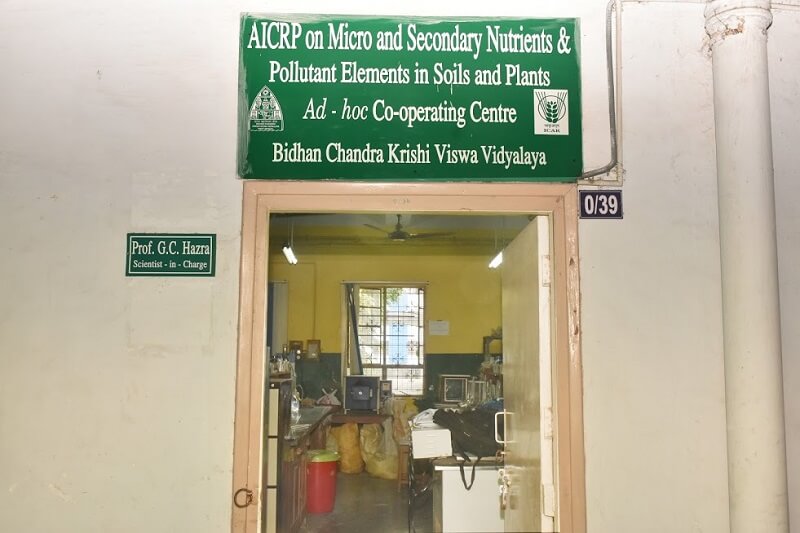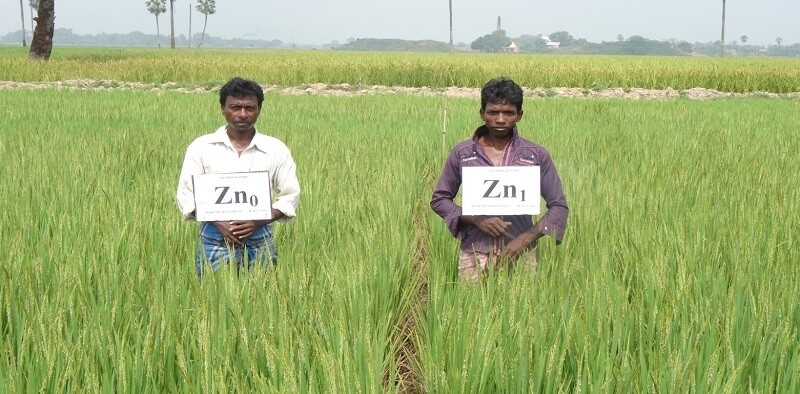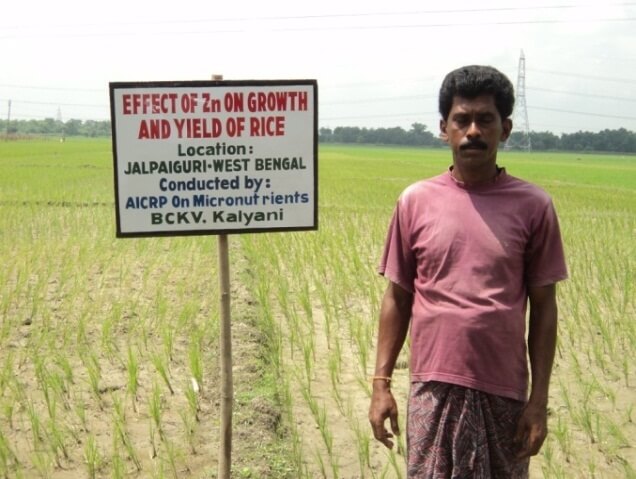AICRP on Micro and Secondary Nutrients and Pollutant Elements in Soils and Plants
The importance of micronutrients has been realized when micronutrient deficiencies were observed in most of the soils of our country which in turn hamper the sustainability of crop production. The farmers are too reluctant to use micronutrients in their own field owing to lack of knowledge about it. Based on this scenario AICRP-MSPE project was initiated and it was implemented in our centre in the year 2009 under the supervision of Prof. G. C. Hazra as Scientist-in-Charge. In a very short period of time this centre has delineated micro and secondary nutrients of 14 districts of West Bengal and also prepared soil ATLAS at block level with the help of NATMO, Govt. of India which has been appreciated from various corners particularly by the Govt. of West Bengal and also by the ICAR. Through this delineation, micronutrient deficient areas are delineated at the block level of a district which will be very helpful to guide the farmers whether micronutrients would have to apply or not in his/her field.
Besides this, during this short period this centre has developed various technologies for alleviation of micronutrient deficiency which will immensely help to increase the crop productivity as well as to improve the quality of the produce. Heavy metal pollution and arsenic toxicity in various locations of West Bengal were also evaluated.
Recently QRT evaluation of AICRP-micro and secondary nutrients and pollutant elements in soils and plants throughout India was done during the period January to March, 2018 and as per the assessment of QRT our centre i.e. BCKV centre has been selected as the best centre in the eastern region of India. This is a very prestigious matter of our University.
Year of start/ establishment of the project: 12.05.2009
Staff Strength:
- Scientist-in-Charge- 1 (Non remunerative)
- Research Associate- 1
- Senior Research Fellow-1
Infrastructure Available:
A laboratory has been developed with the following instrumental facilities -
- Single distillation apparatus (Borosil)
- Digital pH meter (Systronics)
- Electronic balance
- GPS
- Computer and printer
- Sand hot plate
- Mechanical hot air drier
- Horizontal shaking machine
- Spectrophotometer (Systronics)
- Turbidity meter
- Muffle furnace
- Willy mill grinder
- Centrifuge (Eltek)
- Rotary shaker and Atomic Absorption Spectrophotometer.
Mandate/ Objectives:
- Delineation and reassessment of micro and secondary nutrients deficient areas and updating soil fertility maps
- Refinement of critical values of micro and secondary nutrients in soils and standardization of soil test methods
- Amelioration of micro and secondary nutrient deficiency in crops.
- Assessing influence of P build up on the availability of micronutrients in soils and its nutrition.
- Monitoring of heavy metal toxicity in relation to soil-plant-human/animal continuum.
- Delineation of As pollution in different districts of West Bengal.
Salient Findings:
- Zn application @ 5 Kg ha -1 as basal with one foliar spray at the time of maximum tillering stage increased the rice yield to the tune of 11-21% on an average.
- Experiment on biofortification of Zn in rice showed that Zn application through soil plus foliar was effective to increase its content both in grains and straw. Foliar application @0.5% ZnSO4.7H2O should be done at two stages- one at maximum tillering stage and another at booting stage.
- B deficiency alleviated through B-spraying @ 0.25% borax / solubor and two sprays are sufficient in most of the crops – one maximum foliage and another at before flowering. On an average B-spraying helps to increase the yield about 10% over control in case of wheat, mustard, cabbage and cauliflower.
- Gypsum application @40 kg/bigha for groundnut cultivation was very much effective to increase the yield of groundnut and on an average it caused 20% yield increase.
- Both calcite and basic slag as a liming material increased the grain yield of rice in acid soils of West Bengal. They were effective when applied @ 1/5th Lime Requirement (LR) dose than 1/10th LR. On an average basic slag @6.7 quintal/bigha singly caused 20% increase in rice yield over control.
Recommendations:
| Sl. No. | Name of element | Crops/ Cropping systems | Commonly used sources | Doses and method of application |
|---|---|---|---|---|
| 1. | Zn | Rice | ZnSO4.7H2O | Apply Zn @ 5 kg ha -1 (25 kg ZnSO4. 7H2O ha -1)as basal+ one foliar spray of 0.5% ZnSO4.7H2O |
| 2. | B | Rapeseed, Mustard and Mung bean | Borax | Application of borax @ 1kg ha -1 and one foliar spray of borax@ 0.25% |
| 3. | B | Cauliflower, Broccoli and cabbage | Borax | Application of borax @ 10 kg ha -1 and one foliar spray of borax @ 0.25% |
| 4. | S | Rapeseed, Mustard and Mung bean | Gypsum | Apply 25 Kg S ha -1 to the S deficient crops |
Achievements
- During a very short period of time this centre has delineated micro and secondary nutrients of 14 districts of West Bengal and also prepared soil ATLAS of the districts at block level with the help of NATMO, Govt. of India
- Through various on-farm trials it was revealed that Zn application @ 5 Kg ha-1 as basal with one foliar spray at the time of maximum tillering stage increased the rice yield to the tune of 11-21% on an average
- Through farmers’ trial it is revealed that combined application of B and Zn along with FYM (FYM@ 5 t ha-1 + B @ 0.2% borax as foliar spray + Zn @ 5 Kg ha -1) was very much effective to increase the yield of potato to the extent of about 27 % for Kufri Chandramukhi and 12 % for Kufri Jyoti
- Through on-farm trial it was also revealed that application of Zn (5 Kg ha -1), S (40 Kg ha -1) and FYM (5 t ha -1) had remarkable influence to increase the pod yield of groundnut (about 59 % yield increase over control)
- It was also found that vegetable crops grown on sewage treated soils were severely contaminated with heavy metals viz. Pb, Cd and Ni and their toxicity was ameliorated by the application of lime (2.5 t ha-1 ) and FYM (5 t ha -1 ) is recommended
- Regarding Zn-P interaction, results revealed that up to 80 Kg ha -1 there was no antagonistic effect of P on Zn in the soil
- It was also revealed that AB-DTPA is superior to DTPA and Mehlich-3 for determination of available Zn content in soil
Extension Activities for Transmission of Technologies:
- Participated in a live TV programme on ‘Remediation of Arsenic toxicity in West Bengal’ held on July, 2016
- Organized a farmer’s awareness programme about the importance of micro and secondary nutrients in plants and animals was organized in Paschim Palla village, Memari-II of Burdwan district
- Organized one-day Farmers’ Training cum Awareness Programme cum on the topic “Use of micronutrients in Agriculture” at FACC, BCKV, Kalyani
- Organized a National Seminar on ‘Nutrients and pollutants in soil-plant-animal-human continuum for sustaining soil, food and nutritional security - way forward’ during June 09-10, 2017 at BCKV, Kalyani
Recognition:
- A research bulletin entitled “Micronutrient Research in West Bengal” was published highlighting the micronutrient research in West Bengal which has given an insight view about the importance of micronutrients for sustaining the crop production
- Prepared Soil Atlas of Micronutrient at block level for fourteen districts of West Bengal published on 9th June at BCKV (National Seminar on Nutrients and pollutants in soil-plant-animal-human continuum for sustaining soil, food and nutritional security - way forward) with the help of NATMO, Govt. of India
- A bulletin was also published in Bengali language on the topic entitled ‘Delineation and mapping of micronutrient status in different districts of West Bengal and remediation of their deficiencies’.
- One popular article entitled “Agronomic Bio-fortification for ensuring Zn nutrition” has also highlighted the project works
- One book chapter entitled “Micronutrients and Crop Production” also narrated the micronutrients efficiency in different crops







